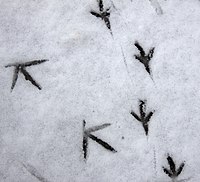
An animal track is an imprint left behind in soil, snow, or mud, or on some other ground surface, by an animal walking across it. Animal tracks are used by hunters in tracking their prey and by naturalists to identify animals living in a given area.[1]
Books are commonly used to identify animal tracks, which may look different based on the weight of the particular animal and the type of strata in which they are made.[2]
Tracks can be fossilized over millions of years.[3] It is for this reason we are able to see fossilized dinosaur tracks in some types of rock formations. These types of fossils are called trace fossils since they are a trace of an animal left behind rather than the animal itself. In paleontology, tracks often preserve as sandstone infill, forming a natural mold of the track.[4]
Gallery[edit]
-
Chelonia mydas tracks.
-
Ant trail.
-
Antelope tracks.
-
Bear tracks.
-
Cat tracks in snow.
-
Deer tracks in snow.
-
Dinosaur tracks.
-
Dog tracks in snow.
-
Elephant tracks.
-
Lion tracks.
-
Rabbit tracks in snow.
-
Raccoon tracks.
-
Squirrel tracks in snow.
-
Tiger tracks.
-
Beaver tail print on snow
See also[edit]
- Flukeprint, track of whale on ocean surface
- Footprint
- Pugmark
- Spoor (animal)
References[edit]
- ^ Staff. "Animal Tracks: What Do They Reveal?". Smithsonian National Zoological Park. Archived from the original on July 29, 2016. Retrieved April 7, 2016.
- ^ Evans, Jonah (2014). "Field Guides to Animal Tracks". NatureTracking.com. Retrieved April 7, 2016.
- ^ Vitkus, Allison; Chin, Karen; Lockley, Martin. "Fossil footprints through geologic time". University of California Museum of Paleontology. Retrieved April 7, 2016.
- ^ Milàn, J.; Christiansen, P.; Mateus, O. (2005). "A three-dimensionally preserved sauropod manus impression from the Upper Jurassic of Portugal: implications for sauropod manus shape and locomotor mechanics". Kaupia. 14: 47–52. Retrieved March 2, 2014.













